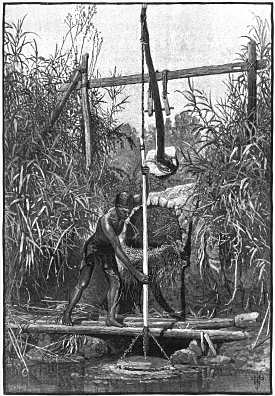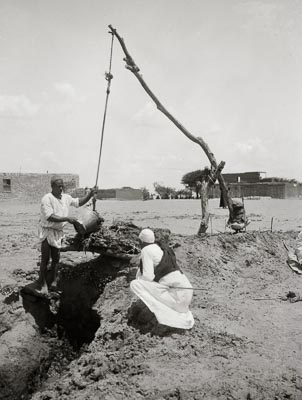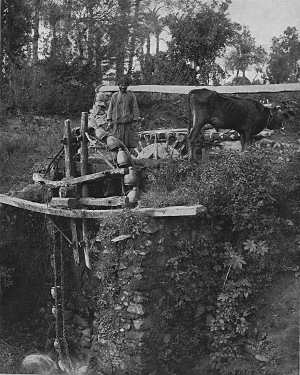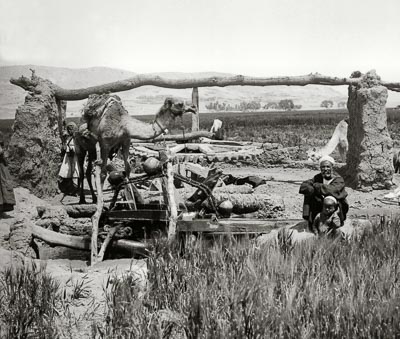
Water in Egypt

Source: Picturesque Palestine, vol. 4, p. 187
Shaduf
Egypt has a soil of sand, and as we have already said, depends on the annual overflow of the Nile for its fertility. In the dry season, to supply gardens and fields with water, pumps of various sorts are used. The "Shadoof" is a very ancient invention for raising water. It consists of "two posts about five feet high and three feet apart, connected at the top by a horizontal bar; across this is a branch of a tree having at one end a weight composed of mud, and at the other suspended to it by two palm sticks, a bucket made of basket work or matting or of a hoop with wooden stuff or leather." One man may work this machine and lift water as much as six or eight feet by it. He may keep on the whole day bowing and rising as he works, doing it all in graceful fashion. (Source: Earthly Footsteps of the Man of Galilee, p. 46.)
Shaduf

Source: American Colony: Egypt and Sinai
As we see the Bedouins drawing water from the Nile in our picture the nations and people of Egypt have drawn water through all the ages of its prolonged history. Customs do not easily change in the East. Labor is cheap and modern machinery of the labor saving kind has not to any extent been introduced into Egypt. Merchandise can be transported on the backs of camels more cheaply than by the railway. The cheapest thing in Egypt is human muscle, and until Egyptians are educated to a higher plane of life they will continue to draw water as they have always done. The water is drawn in buckets and is then emptied into little ditches which are cut through the fields. In this way they irrigate the soil. (Source: Earthly Footsteps of the Man of Galilee, p. 41.)

Source: Earthly Footsteps of the Man of Galilee, p. 46
Drawing Water
The "Sakeyeh " is another pumping arrangement. It is made of jars or pots fastened on a wheel which is sometimes twenty or even twenty five feet in diameter. Around its circumference are attached earthern pots or jars by a system of cogs. The great wheel is kept turning by connections which are made with a horizontal wheel which cattle or horses keep in motion. In the picture we see to the left the wheel with its jars, and to the right is a buffalo or cow treading about the circle. In this way the gardens are supplied with water. The thirsty land during a part of the year has great need of this service, and most delightfully does the soil respond to the labor of the water-drawer by Shadoof and Sakeyeh--in flowers and sod, in shrub and grain. (Source: Earthly Footsteps of the Man of Galilee, p. 46.)
Egyptian Irrigating Wheel

Source: American Colony: Egypt and Sinai
When the creaking wooden wheels are in motion the earthenware jars, strung to ropes made of palm fibre, revolve, alternately dipping into the water and emptying themselves into a trough connected with a reservoir . . . . In Nubia these sâkiyehs take the place of the shadûfs of Upper Egypt, and though they are costly to erect they effect a considerable saving of labour. (Source: Picturesque Palestine, vol. 4, pp. 157, 233.)
See Nile River, Flooding of the Nile River, Water Supplies, or Water Systems in Jerusalem
At BiblePlaces, see Nile River Valley